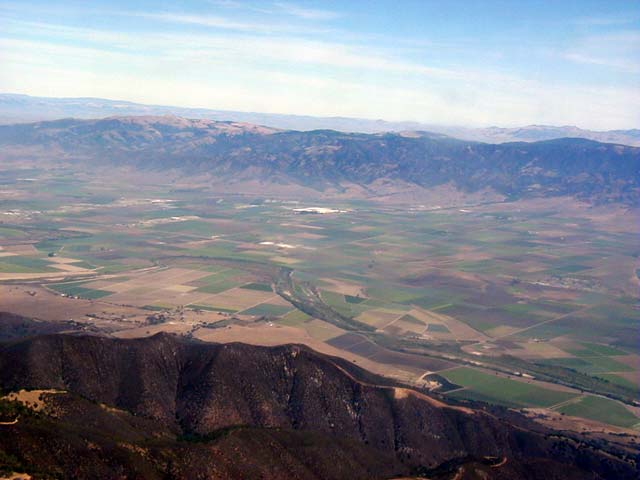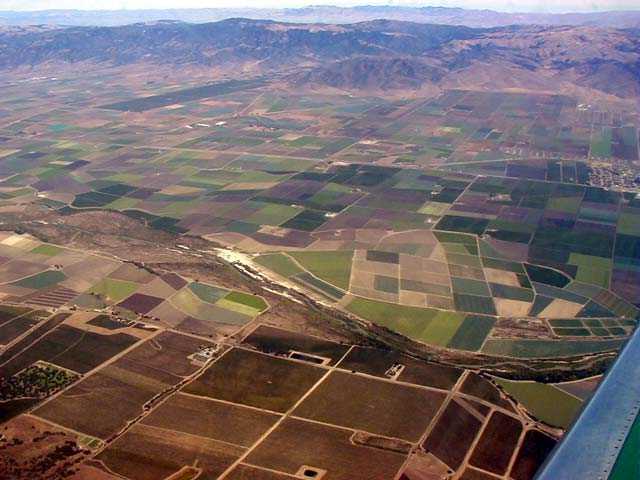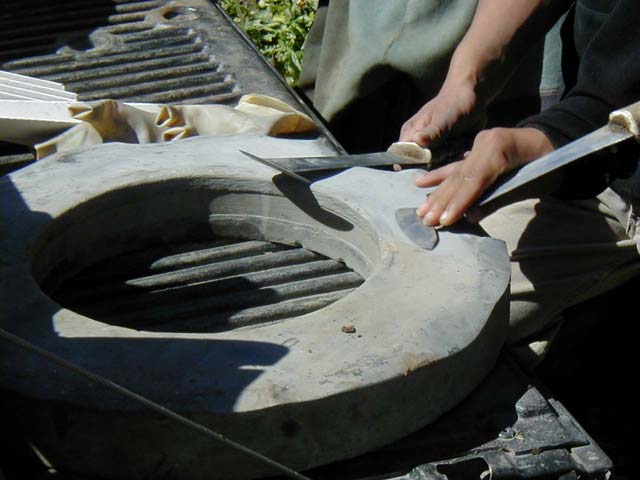Harvesting
Celery in Salinas, CA
"The Salinas Valley is in Northern California. It is a long narrow
swale between two ranges of mountains and the Salinas River twists up the
center until it falls at last into the Monterey Bay." - John
Steinbeck, East of Eden, (1952)
"The Carmel River is a lovely little river. It isn't very long but in
its course it has everything a river should have." -John Steinbeck, Cannery Row, (1945)
Webpage revised November 20,
2004 BACKGROUND
THE KNIFE
THE SHARPENER
For the past two years I have been consulting with a vegetable grower in
Salinas, CA on improving the sharpening methods used in the fields.
Currently a vegetable cutter will spend up to an hour thinning and
sharpening a new knife before using it in the field, then he will spend
several minutes sharpening it at each break every day. Sharpeners used
range from stones to files to steels. My client wanted to reduce this
labor for the harvesters and produce a sharper, more consistent edge.
A fringe benefit would be to reduce the cutter's resistance to using
stainless steel knives. Stainless knives are being encouraged by the
Ag. Dept., but the cutters realize they are more difficult to sharpen.
BACKGROUND
The Salinas Valley sits between the Gabilan mountain range on the east and
the Sierra de Salinas hills on the west. Up the valley the Sierra de
Salinas peter out and the valley widens over to the San Lucia mountain
range. The Salinas River flows northerly through the valley 150 miles
to the Monterey Bay. US 101 roughly parallels the river through the
valley. Most of the farm land is in the wide northern section of the
valley between San Lucas and Castroville, while the southern end has many
vineyards. Salinas, a city of 150,000 and seat of Monterey County, is
20 miles east of the city of Monterey. Seen from the air the valley is
a mosaic of fields that produce fruits and vegetables from artichokes to
zucchini. Okay, zucchini is an exaggeration, but overall it is the
nation's top vegetable and wine grape producing region, and leads the world
in seed technology, growing and harvesting methods, and processing
technology.


While we also worked on head and romaine lettuce, broccoli and cauliflower,
the celery knife was the most challenging.

A celery field being harvested.
First the celery stalk is cut from the root, then the root end is
trimmed.

Then the stalk is cut to length.

Harvesting up to 3000 stalks a day, the cutter makes between 12000 and 20000
cuts. The cutters (below, left) pass the stalks to the packers
(center) where they are washed, wrapped and boxed (right). The boxes
are put on skids and loaded on trucks. With all the processing done in
the field, all that remains is refrigeration and shipping. The
harvesting machines are 50 ft. wide and cover 12 to 16 rows, and 100 ft.
machines are in development. Each crew has 12 - 16 cutters and an
equal number of packers, plus drivers and handlers.

THE KNIVES
Some crops, like cauliflower and broccoli, are harvested with butcher
knives, and even the lettuce knife is not that much different. The
celery knife, below, is unusual. It evolved just for this crop, and is
not used for any other. The tip is rotated 90 degrees and angled for
cutting the root. Although these knives have been made from scratch,
most are made by cutting and welding butcher knives as below.

It has two sharp edges, the tip and the side. Here one cutter is
sharpening the edge while another is sharpening a well worn tip. The
top side is ground flat while the bottom side is convex - a sort of modified
chisel grind.

THE SHARPENER
Our challenge was to find a sharpening method that could be used in the
field. Another consultant from the meat packing industry walked away
from this because the farmers did not have a sharpening room.
As I mentioned, stones, files and steels were being used and, in the picture
above, a salvaged industrial grinding wheel. Electric power was
available of some of the harvesting equipment, and my client was willing to
add a generator to the others. We experimented with a variety of
sharpeners - slot devices, wet and dry grinders - an finally settled on a
belt sharpener after it was observed that the small motor could be replaced
with a 12V motor and used right at one of the trucks in the field. The
other advantages of a belt sharpener are that belts are easily changed, and
there is both a straight section for flat bevels and a slack belt section
for convex bevels. We bought a small motor and modified ours that same
day. It turned out to be under powered and the sharpener we were using
is no longer available, but it got us off to a good start.
Our next design was a Koval Knives' Little Sharpie modified with a
large 12V motor. It was more powerful and heavier than we
needed. We based the final design on a low cost 1" x 3" belt
grinder. The right size motor and a special drive pulley gives
the proper belt speed, and a new base allows operation in the horizontal
position. For more details, see field.htm

Cutters like their knives to be very thin and sharpened to a 15 degree
single bevel (chisel grind). The initial preparation of a new celery
knife, taking off the original double bevel, thinning and sharpening, took
about an hour manually. With this sharpener it can be done in under 5
minutes. Sharpenings throughout the day take just seconds. Our
project has been a success!
Steve Bottorff
BACK TO TOP
Copyright 1996 - 2025 by Steve Bottorff








